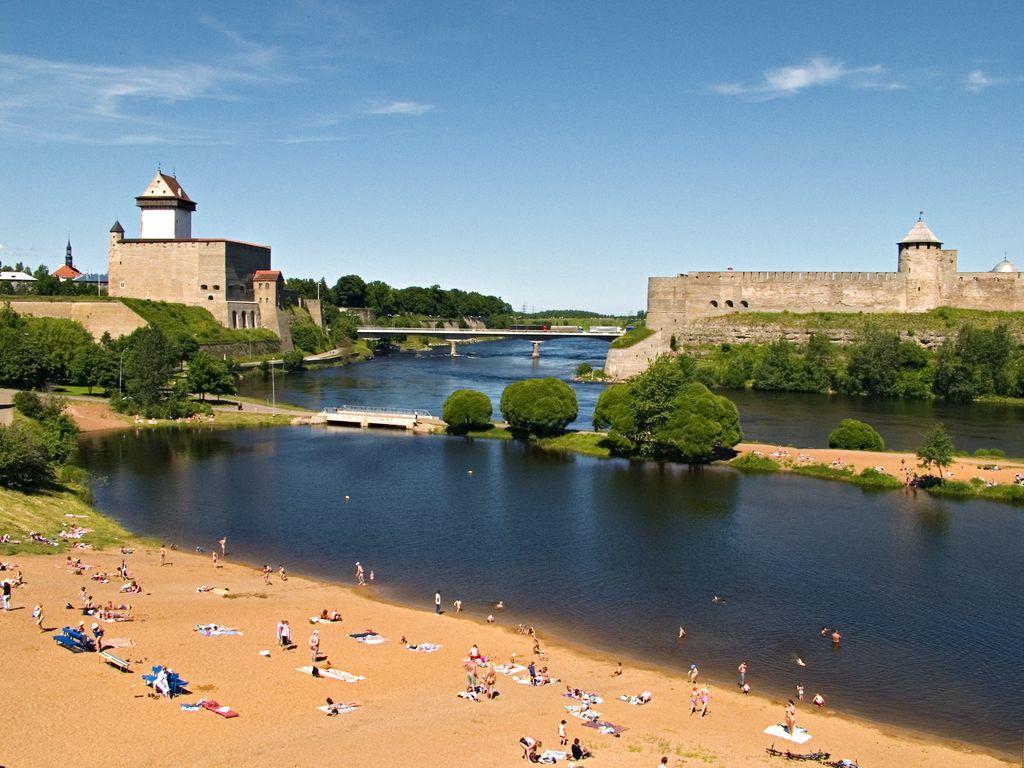A Tale of Two Cities
"It is a different world over there."
"You see and feel the difference as soon as you cross the bridge across the river -- the roads, the bureaucracy, the mentality."
Sergei Stepanov, former editor, Narvaskaya Gazeta, Narva, Estonia
"It is not really even a town over there -- just a road or two."
"Of course, it is better here in Narva than in Ivangorod."
Vladimir Petrov, leader, Union of Russian Citizens
"We are all Russians, but we have a different mentality here."
"We are used to European ways."
Leonid Pelesev, chess coach, Narva
 |
| Photo by Jaak Kadak. Nova (on the left) prospers while Ivangorod the Russian town across the river, is slipping ever further behind. |
It was once a city, but now the city that once was, under Soviet Union rule when Estonia was just a part of the Union of Soviet Socialist Republics, is now two towns; one located within the border with Russia, the other just across the border, in Estonia, with a river separating the two and a bridge connecting the two halves that once comprised a unified city. The bridge itself fell into disrepair and has only recently been reopened after refurbishment made it usable once more.
But it isn't only the Narva River that has so effectively divided those two towns, of which both populations are Russian speaking, ethnic Russians. Narva has a population of roughly 60,000 (80% ethnic Russians) as compared to Ivangorod in Russia with about 12,000 inhabitants. For its population, Narva boasts modern hospitals, swimming pools, shopping malls, a university and freely accessible Wi-Fi. In sad contrast Ivangorod has none of these civic amenities.
That does not describe the only differences between the two; wages, for example; the average monthly wage in Ivangorod is $500, in Narva it is twice that amount, while pensions between the two compare on an even wider scale. Russian speakers in Narva watch Russian state television and think highly of Vladimir Putin, though they are content to live in Narva as a considered choice, spurning the alternative, to live in Ivangorod.
The European Union gave both of the towns funding to enable them to build promenades on each of their sides of the Narva River, as a manner of prompting cross-border harmony between the two Russian-speaking civic enclaves and promoting tourism in the process. Narva received $830,000 and with it completed their promenade which turned out eight times longer than the one Ivangorod built for the $1.2-million they were given.
 |
| Narva River promenade Estonian World |
Ivangorod officials explained that topographic challenges accounted for the differences in both cost and completed project, while critics in Narva point to what they say accounts for the reality leading to the fact that for less funding the Estonian town completed a much more sophisticated and longer promenade; fusty old bureaucracy leading to systemic problems characterized as corruption. "Almost certainly" corruption was the reason for the disparity between the two end results, according to the former editor of a Russian-language newspaper published in Narva.
Ivangorod is the site of a venerable old fortress built in 1492. The Church of the Holy Trinity is also located there, a cluster of spires and cupolas, situated on the edge of a lake, and newly renovated from the ruined state it fell into during Soviet rule. Russia's state railway company provided the funding for its renovation. Because of the church, the fortress and a few museums, the Russian town is an excellent candidate for tourism.
Unfortunately, most visitors are unable access the site since all Russians living outside the border area, along with any foreigners wishing to visit must first submit an application to obtain permission from the Leningrad Region branch of the Russian interior secret agency, the F.S.B. The process can take up to four months for the needed permits to visit Ivangorod. Try to visualize a tourist sticking around for that length of time to be enabled a half-day visit to the town.
Narva too has a fortress and museums, both of which are freely open to anyone living in Estonia, as well as to foreign visitors. A venture to initiate a shuttle bus service to Narva from Ivangorod was initiated by the European Union funding it, abandoned however when the Russian town insisted on requiring $4-million just to build a bus stop.
In contrast, in Narva, where salaries are higher and construction materials costlier, it was felt that $1-million would suffice to build a bus shelter. In Narva, streets are clean and in good repair, contrasting with those in Ivangorod, scarred by potholes and debris-laden. As Ivangorod's mayor lamented, the town is classified as a restricted border zone.


<< Home